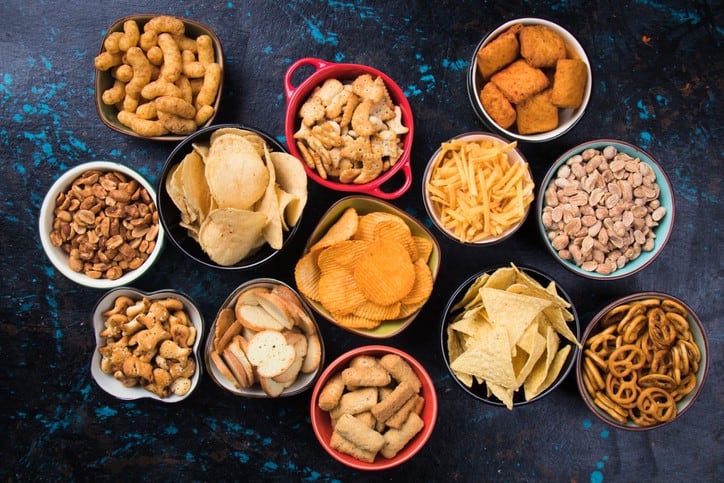The study was a cross-country one conducted by public health researchers across Australia and Norway and involved the analysis of 43 studies involving UPF in relation to any disease, disorder or condition specified in the International Classification of Diseases.
It utilised a food classification called NOVA (a name and not an acronym) which assigns foods to four groups based on the ‘extent and purpose’ of their industrial processing – Unprocessed/Minimally Processed Foods (MPF) e.g. fresh fruit, vegetables, meat, milk; Processed Culinary Ingredients (PCI) used to cook and season MPFs but not consumed alone e.g. salt; Processed Foods (PF) where PCI is added to MPF and sold e.g. canned fruit in syrup; and UPFs which contain multiple ingredients and are produced via various ‘industrial processes’ e.g. savoury snacks and confectionary.
UPFs would ‘characteristically’ contain substances such as maltodextrin, hydrogenated oil and cosmetic additive to improve taste.
Out of the 43 analysed studies, 86% (37) of these reported a statistically significant association between UPF consumption and at least one adverse health outcome, whether these were a disease, disorder or chronic condition, which the researchers believed this to be related to the processing of these foods.
“Exposure to UPFs was found to be associated with [adverse health outcomes] such as Type 2 diabetes, cardiovascular disease, coronary artery disease, overall cancers, depression, mortality and more,” they said.
“[Not a single] study reported an association between UPF exposure and any beneficial health outcomes that reached statistical significance, [but] beneficial outcomes were found associated with diets higher in MPF or MPF combined with PCI or PF – [foods] which did not go through the complicated processing that UPFs did.
“[Individual nutrients] like salt and sugar [were also adjusted for in some of the studies], but associations between UPF exposure and [the] diseases being investigated remained even after these adjustments.
“[These] suggest that something other than nutritional factors may be contributing to the recorded observations, [thus] the postulation is that there are possible synergistic effects between the many compounds in a UPF [leading] to adverse health outcomes.”
The majority of public health regulatory measures today focus on individual nutrients such as salt or sugar taxes, but according to these findings, single-nutrient policies may not be enough to produce beneficial health impacts.
As such, the authors highlighted the need to recognise UPFs as an overall concept to describe unhealthy diets, and to incorporate this into policy implementation as opposed to focusing on individual nutrient taxes or measures.
“[We believe] the findings in this review support the notion that inferring health effects from individual nutrients and ingredients in foods is insufficient, and that industrial processing, and its extent and purpose, may add accuracy and reliability in predicting and explaining associations between foods and health outcomes,” they said.
“There is now a considerable body of evidence supporting the use of UPFs as a scientific concept to assess the ‘healthiness’ of foods, [and to] recognise this concept as a descriptor of unhealthy diets.
“Food-based dietary guidelines and nutrition policy actions should consider incorporating the concept of ultra-processing to describe the healthiness of individual foods [and] to help inform the development of [future] policies.”
Junk food tax
Junk food taxation is arguably the most similar policy to governance based on UPFs, as it comprises ‘non-essential’ foods that are overall high in sugar, salt and fat content, and tend to be highly processed as well.
There are several countries that have implemented such a measure, including Mexico and Hungary. The World Health Organisation’s (WHO) analysis of the latter found it to be impactful on consumer purchasing choices.
“Many food manufacturers have reduced or eliminated unhealthy ingredients in their products, population awareness of healthy eating has increased, and approximately US$ 219 million in revenue has been raised and earmarked for health spending,” said the WHO.
“Consumers of unhealthy food products responded to the tax by choosing a cheaper, often healthier product (7% to 16% of those surveyed), consumed less of the unhealthy product (5% to 16%), changed to another brand of the product (5% to 11%) or substituted some other food (often a healthier alternative).”
Closer to home, the Philippines is also considering the implementation of a junk food tax, particularly foods high in trans fats and sodium.
The findings of this study were in contrast to a New Zealand modelling study published earlier this year describing sugar taxes as the most effective type of food taxation for public health, scoring above taxation for saturated fat, salt and junk food, although this was done solely for a New Zealand population.
Study: Ultra-Processed Foods and Health Outcomes: A Narrative Review
Source: Nutrients
Authors: Elizabeth, L. et. al.





